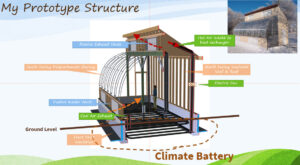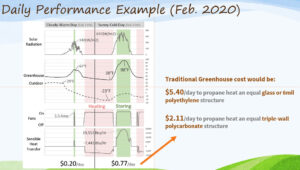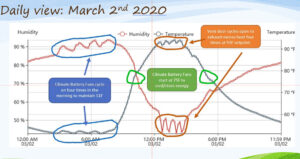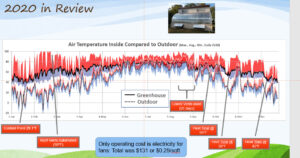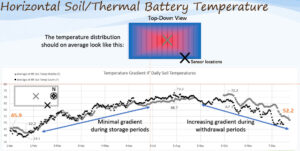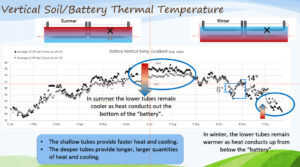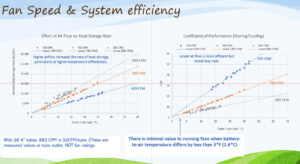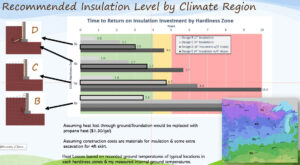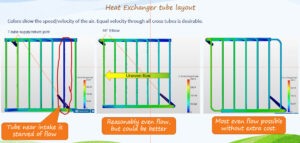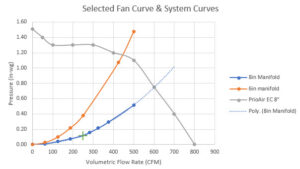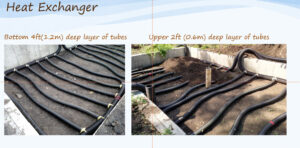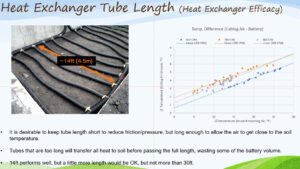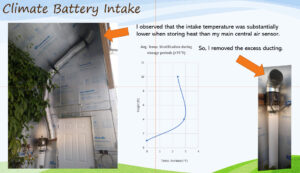Final report for FNC19-1185
Project Information
Our 50-acre operation started in 2011 when we moved from Brookings, SD to rural Brookings county after living in town for several years following college. My wife and I both grew up in farming families and desired to raise our children in a similar environment.
Our small operation consists of 30 acres of pasture and 20 acres of grass hay ground. We started off raising Boer meat goats in 2012. We eventually added Jacob sheep and Scottish Highland cattle. In 2018 we started transitioning out of our meat goats in favor of the hardier Jacob sheep and Highland cattle breeds that thrive in our climate with minimal supplemental grain. We currently have 25 sheep and 10 cattle, with a few goats that we’re feeding out.
My primary occupation is mechanical engineering. I have worked for Daktronics, Inc for 16 years, initially designing large industrial cooling systems for our electronic display systems installed across the world. I enjoy computer modeling of advanced customized heating/cooling systems as well as solar heat load simulations for our electronic display systems. I have continued to specialize in product research and testing while currently managing our 15-person testing laboratory. In addition, I contribute to international standards committees and present at industry conferences regarding research.
Growing up I spent summers working for the Hutchinson, Brule, and Buffalo County conservation districts planting, cultivating, and caring for trees. Through this I developed an interest in horticulture, pursuing it primarily as a hobby. While traveling for work and vacation, I developed an interest in the wide range of fruit that is unheard of in our northern climate.
I started saving seeds and soon started so many tropical and sub-tropical trees that I didn’t know what to do with them. While seeking a market, I discovered the demand for exotic tropical fruit trees was robust because they are regularly ravaged by seasonal hurricanes. Examples of the many plants I’ve successfully propagated include soursop, mamey, Garcinia humilus, Garcinio madruno, cherimoya, Monstera deliciosa, passion fruit, etc.
This project allows me to combine my engineering and research expertise with my horticultural experience and exotic plant business. The goal is to develop cost effective and sustainable growing environments, enabling alternative niche crops locally in South Dakota. One day I would like to grow year-round produce that cannot otherwise be grown locally, to meet the demand of our local international student population.
Cold northern climates prevent year-round crop production and make greenhouses too costly for tropical produce. This results in long distance shipping of fruits and vegetables from central America and prevents many types of delicate produce from being available in local markets.
The proposed research will produce data regarding design trade-offs of multiple passive solar greenhouse features as well as demonstration of a selected design. Low cost/high efficiency greenhouse technology could transform our energy intensive food supply chain to a lower cost, more diverse and sustainable system that will improve quality of life for producers and consumers in northern climates.
Unique aspects of this project include:
- Application of advanced mechanical engineering tools typically reserved for high-cost aerospace and medical industries to northern greenhouse designs.
- A focus on year-round production vs. season extension.
- A demonstration site eight miles from South Dakota's largest agricultural university.
- A naturally sustainable gravity fed spring water source for crop production.
The construction of this highly efficient, cost minimizing greenhouse will allow further development of an exotic plant and fruit horticultural business and expansion into local produce business.
Primary objective: Minimize total cost of greenhouse ownership to enable sustainable production of tropical plants and produce.
- Research, design and simulate multiple in-ground heat storage configurations to maximize heat storage while minimizing electricity usage.
- Minimize summer cooling costs through a fully passive natural convection cooling system.
- Design and construct gravity fed spring water supply system.
- Construct the proposed greenhouse design based on simulation results.
- Monitor key performance parameters and compare to design simulation results.
- Share findings through Year-Round Greenhouse Facebook group, Wayward Springs Farm Web-page, conference presentations, local college classroom presentations as well as public open-house tours.
Research
Design analysis and calculations will be performed utilizing open sourced SimScale CFD (Computational Fluid Dynamics) software and the free Therm 7.6 software for 2D simulations published by Berkeley Lab. Many other tools and references will be utilized such as Microsoft Excel for calculations, engineering manuals and prior research by others.
The key elements of the passive solar greenhouse will consist of:
- 28' x 16' greenhouse orientated east-west. This allows the south facing walls and roof to be glazed allowing maximum solar heat capture during the coldest months. North wall and roof will be insulated to minimize winter heat loss and maintain cooler temperatures during the hottest summertime months with minimal energy costs for both seasons.
- A soil based in-ground heat storage system to provide the most cost-effective method for heat storage to stabilize daily temperature fluctuations. Main features: insulated 4' deep concrete foundation, 2-layers of 4" drain tile arrays in the soil for the air-to-soil heat exchanger, in-line duct fans for air circulation.
- The southern knee wall and roof peak will have automatic openable doors to allow free natural convection cooling during the hottest summer months.
- Multiple wall materials for the north facing structure will be considered. Wall construction similar to UMN DWG 2.2 design was utilized for the north wall construction.
- The southern wall/roof will have triple walled polycarbonate glazing to allow maximum light penetration and minimal heat loss. It will be supported by arched aluminum truss-work.
- I will install a gravity fed water supply system that utilizes local spring water for growing.
After construction, on-going performance of the system will be monitored via:
- Temperature loggers buried in the soil to monitor thermal storage capacity and charge/discharge rates.
- Air temperature loggers to monitor resulting growing conditions
- Electrical current monitoring of the fan circulation system to track energy usage.
Prototype Design:
Greenhouse performance measurement tools:
Temperatures, Humidity, Electricity Usage, Ground/Earth Battery Temperatures were measured utilizing iMonnit sensor systems that record readings every 10minutes and store data online in a cloud storage system.
Incident solar irradiation was measured utilizing an Onset HOBO Pendant lux meter & compared to a Li-Cor Pyranometer to determine W/m2 irradiation levels.
Local outdoor weather data at hourly sampling intervals was purchased to minimize instrumentation costs.
Detailed example data for two cold winter days is shown below. Feb 13th was our coldest night on record for 2020 and demonstrates how well the system can perform.
Very large energy cost savings can be realized using a climate battery with a well insulated greenhouse structure. For a structure my size I experienced a worst case daily cost of $0.77 of electricity to operate the system. To maintain the same temperatures using conventional heat in my structure would have been $2.11 per day. In a standard single layer PE film greenhouse of this size it would have been $5.40 per day.
Detailed temperature data for a typical sunny day in March shows how effective the automated upper vent doors are at cooling the system. Automation via thermostat controlled linear actuators was very effective. The lower ventilation doors we only used for a short period of time in August and September so automation is not necessary or cost effective for them.
An overview of the year's temperature data compared to our outdoor ambient temperature is shown below with notes. No external heat or other energy sources were used in the structure to allow characterizing of the heating system.
Characterization of the soil/battery temperature profile is provided below. This data is helpful to understand how much net heat is being used/stored as well as developing cost-benefit trade-offs for the amount of foundation/climate battery insulation that is worth while for others looking to build their own system.
Horizontal temperature distribution through the entire year:
Vertical temperature distribution throughout the year:
Total heat energy stored & extracted can be calculated from the air temperature, humidity & air flow rates into and out of the system. This data is useful for understanding how much heat & cooling a climate battery can be expected to provide so better choices can be made about the level of insulation, glazing choices and other expensive aspects of greenhouse design.
In order to understand the effectiveness of various airflow rates through the climate battery I collected data for several days at three different fan speed settings as well as calculated the efficiency (CoP, Coefficient of Performance) of the system for those airflow rates. The data was in line with some example research papers that I've found. Increasing airflow beyond what my fans can do will continue to increase performance. I did not hit the point of diminishing returns for this tube layout.
Educational & Outreach Activities
Participation summary:
SDSU Ag Student Tour:
One faculty and 5 students interested in passive solar greenhouses and year-round production toured the greenhouse January 23rd. Information was communicated verbally, by email and text with some additional follow-up afterwards. This was an early tour prior to having much data collected. We are planning tours again later after more time and information are available, and will potentially teach a class on the topic in the spring or fall semester.
Jan. 2021 I did a class presentation on passive solar greenhouses for the SDSU Local foods students remotely via Zoom. It was recorded and used again for future classes. The slide-deck for that presentation is attached.
Farmer/Grower Tours:
Gave two individuals a tour Feb. 15th showing the structure, function of the system and discussing pros/cons of many various designs and materials used in this structure and other various configurations. They are interested in building a system like this near Mission Hill South Dakota. They found out by word of mouth and then Facebook.
Due to the COVID pandemic a full-scale open-house was not planned, but instead we did tours throughout the year, which took a lot more time, but also provides better one-on-one discussion. The number of tours exceed 45 different ones from local farmers, other researchers, and others interested in building a similar system. I have several tours scheduled after the completion date of this project as there is a very high interest in this topic.
Poster Presentation for MOSES Conference:
I will be doing a poster presentation Feb. 27 and 28th, 2021 to attendees to Midwest Organic & Sustainable Education Service (MOSES) Conference. The audience will be a diverse cross-section from academia to farm operators and students. See attached poster.
I also did a final project summary poster for the 2021 MOSES conference. This is a recorded 6min overview of the project and some of the results. It is attached in the project materials.
Regular Facebook Project Posts:
I've been posting updates, photos and discussion on the Deep Winter Greenhouse group on Facebook as well as my Wayward Springs Farm page to cover a wide variety of interested persons.
Press Articles:
Farm Show periodical interviewed me and did an article featured on Page 6 of Vol.45, No.1 2021. I've received several inquires for more information via mail. This was a great tool to reach people that do not regularly use internet/computer for information/news.
NAFEX Annual Conference:
In early January 2021 I did a 1.5hr presentation with Q&A for this conference via Zoom. There were approximately 30-40 attendees and I observed really good audience engagement and interest. The slide deck is attached as well as it was recorded and available to NAFEX members online.
SD Master Gardeners & SD Specialty Producers Webinars:
I just finished up a two part webinar series with Q&A that was done via Zoom and hosted by SDSU extension. It was recorded and available on the extensions website. We had 260 people register for the series and over 175 attendees. The recorded videos have several hundred views so far.
Part 1: Intro to Northern Year-Round Passive Greenhouses
Part 2: A Year of Operation, Data and Growing in a Solar Greenhouse
Gravity Fed Natural Spring Water System:
As part of the project, I documented and compiled a video of the construction of our water supply system for our greenhouse. Not many people have natural springs available so it can be difficult to find good examples and photos of someone building one. I compile the info I had into a YouTube video and it is available online at:
Learning Outcomes
Initial engineering simulations and construction of the project was completed during 2019. This included extensive characterization of 6+ configurations for insulating the foundation/climate battery storage system as well as the airflow characteristics through the heat exchanger system. After collecting a years worth of information about how much heat could be collected and stored it is possible to characterize the Cost-to-Benefit or ROI for the various insulation options I analyzed via Therm. The illustration below shows a summary of the options analyzed and their costs:
Based on the annual heat storage quantities and heat loss rates for the various designs it is possible to calculate an ROI assuming the lost heat would have to be replaced with propane. I used my average bulk propane cost of $1.30/gal to place a value on the cost savings assuming an 100% efficient propane heat source (non-vented small scale heaters would be 100% efficient because no flue gases are exhausted). I used historical weather data for outdoor soil & air temperatures for typical locations in USDA hardiness zones 3b-6b for the analysis.
The following diagram shows the recommended insulation configuration for each USDA hardiness zone and the associated years till ROI. Several of the configurations were eliminated for the final recommendations as they had poorer performance than an equal cost option.
I began tracking greenhouse performance parameters December 1st 2019 prior to completing insulation and the climate battery heat storage system. This allowed good characterization of the structure's performance without the climate battery system in place. In best case situation the structure would cool within 10 degrees F of outdoor temperatures by morning time and heat up to 110 degrees F internally on sunny days even in the short hours of daylight in December highlighting the need for a heat storage and supply system to temper these extremes.
As of January 1st 2020 I had the circulation fans for the heat exchanger of the climate battery operating with all of the data acquisition equipment in place. This was delayed past my original plan of fall operation due to our record wet 2019 which slowed construction as well as difficulty obtaining the mineral wool insulation in a reasonable time. However, this ended up being positive because I was able to collect performance data in a near worst case situation of no stored heat from the fall/summer and a record cloudy January of 2020 which gave very little opportunity to store daytime energy for night time usage. Performance was still very good with inside temperatures only falling below 32 degrees F on three occasions when outdoor temperatures fell below -15 degrees F.
Weather patterns changed significantly in February with more sunshine, but colder outdoor weather. The change in number of sunny days far outweighed the colder February temperatures. To date the greenhouse has not experienced any days below 32 degrees F inside during February even with an outside low of -24 degrees F!
It appears as though some of the radishes I seeded on Jan. 10th will be ready to harvest by the end of February! Some other experimental plants like lettuce seeded at the same time are doing well and not far from a first harvest. Some other "sacrificial" plants were added in January such as a purple passion fruit vine (Passiflora edulis) and dwarf banana. The banana did not survive the January frosts. The passion fruit had some damage, but wasn't killed.
On January 26th, I moved a cherimoya (Annona cherimola) and a soursop (Annona muricata) to the greenhouse. The cherimoya is a subtropical plant and has been thriving in the climate since then. The soursop is a true tropical and dropped leaves when temperatures fell below 45 degrees F early on. However, it is showing budding and new leaf formation by the end of February.
Engineering simulations of a few tubing layouts provided good visualization of some things to not do on the heat exchanger manifold. It is important to maximize air flow to all of the heat exchanger cross-tubes. Three potential configurations are shown below. The third was used for the prototype build.
The resulting system pressure-flow curves for two manifold diameters were calculated and compared to available fan curves. The following graph shows the comparison of the PrioAir 8" fan and manifold diameters of 6" and 8". Only 6" tubing was locally in-stock when I purchased it so I used that. If I were to do it again I would take the time to drive farther to acquire 8" tubing because the reduction in air flow is even more significant than the plots below show because operating at a higher air pressure forces more air out through the perforated tubing.
For reference here are a few photos of the heat exchanger tubes:
I also analyzed the data to understand how well the heat exchanger was storing the heat I was blowing into it by comparing the outgoing air temperature to the average climate battery soil temperature. In a perfect scenario the exiting air would be the same temperature as the soil. If the tubes are too short a lot of heat will remain in the air without transferring to soil. If the tubes are too long more expensive fans would be required to move the air and the downstream soil will not be absorbing as much heat because it will have already transferred to soil on the upstream side. If the tubes are too short a lot of heat will remain in the exiting air and need to circulate again.
I found that the 14' length was pretty good. I wouldn't recommend significantly shorter, but a lot longer also would be less effective. Further analysis is needed to weight the full range of trade-offs to get an optimal configuration, but it also will have to vary some amount with the layout of the greenhouse structure.
Another lesson learned was that the assumed best location of "roof peak" was not appropriate for my structure. I quickly observed that during heat storage conditions the temperature in the roof peak was noticeably lower than the thermometers lower to the ground. I then installed sensors at several heights to gather some longer term information on the "thermal stratification". I found that stratification was very minimal with highest temperatures occurring around the 4-6ft height. This is because the cross-ventilation induced by the fans overpowers the tendency of warm buoyant air to rise.
I then removed the ductwork for the intake that went up to the peak to allow the hottest air to be pulled into the storage system. See photos and graph below:
Other key lessons learned:
- I would not recommend utilizing an opaque lower knee-wall for intake cooling vents. The climate battery plus upper vents are sufficient cooling for 11 months out of the year in my region. The knee-wall has a significant winter drawback because it casts a shadow onto some of the growing area creating an area of low-light, slower growing plants. I would recommend using shade-cloth instead to reduce the amount of heat during the hottest part of the year. I plan to retro-fit the system this summer to implement those changes.
- I also noticed that starting in February a lot of heat has to be vented out because the climate battery cannot store heat fast enough during the day. The sunlight is very strong for a fairly short period of time. The best way to increase the speed that the battery can be charged is to decrease the tube-tube spacing. I had wanted to do more CFD simulation comparing options, but didn't have time during this project to do that. I plan to build closer tube spacing in my next structure to allow faster/better heat capture. I have found some prior research suggesting 10-14" spacing may be a better option. I need to do some further analysis to get to a specific recommendation though.
- I would also use non-perforated tubing below ground for the intake manifold tubing. The intake manifold has fairly high air pressures, causing ~30% of air to be pushed out of the perforations. This causes the soil above the intake manifolds to dry out faster and more frequent watering for plants in the soil for that region. Utilizing solid tubing for that end would eliminate that, just add a few drilled or cut slots for water drainage.
- In order to allow a snow-free location for the upper vent doors to open-close, I selected a clerestory structure so I could install them in a vertical position. In hindsight this caused a lot of added height, complexity and therefore cost to the north part of the structure. I would like to design doors/vents that are built into the roof next time to reduce the height of the structure, cost and construction complexity. I also found that I didn't provide enough frame-door clearance. I modeled it after standard house/barn doors, but the greenhouse has a lot of humidity and heat so the wood expands and contracts more around the door. I was able to sand down the doors some amount to improve that.
Project Outcomes
I've received a lot of questions, feedback and discussed other farmers' projects with them to help improve their growing! A few examples that stick out in my mind:
After doing the webinars, I had one producer that was already in the process of building a greenhouse for this next spring/summer by Pierre, SD. He had purchased some materials for a solar greenhouse, but was looking for some guidance on how to most efficiently layout the fans & tubes. I was able to use my experience, data and do some calculations for him that will allow him to get over twice as much geothermal heating for the same price as his original layout! I'm excited to see him growing local citrus produce in South Dakota!
I had another farmer reach out to me. He is based out of Pennsylvania and has already installed a couple self designed climate battery greenhouses that he has been using to grow local figs! He has had great success with them so far, but is really excited to get better designs that can enable production of other high dollar crops and help other farmers do the same thing. We discussed potentially collaborating on a future research project to further develop the systems.
Through the project I also met the designer for the UMN Deep Winter Greenhouse project and we have been discussing, collaborating and improving some of the design elements for the new Farmscale models that are being built. I'm excited to collaborate and help that project be successful because the plans are readily available to the public for farmers to reference and use for their farms!
I also had a couple visit from Storm Lake, Iowa. They are planning to build a similar greenhouse this summer for thier personal use along with small-scale commercial/trading with neighbors. They were so excited about the project that they recorded their visit and posted a two part video series on their YouTube channel!
I had a lot of people reach out and thank me, particularly with our recent challenges in our food supply chains throughout the COVID pandemic. It has really highlighted the importance of a stable, diverse, reliable local food supply chains that are not concentrated in a few large factories which can be easily shut-down when emergency strikes their region.
General comments:
- I underestimated the interest I would receive from others as well as the time it takes to communicate about my project to those interested. However, I really enjoy the time spent teaching and helping others. Overall the project took far more time and funds than I budgeted for in the grant proposal, but I understood that going into the project and really appreciate the funding that was provided as well as the encouragement provided by having my grant proposal accepted!
- Farm Show periodical sought me out and published a short article about the project. I've been surprised by how many people have seen my contact info and reached out through that. It ended up being great because it reaches a wider audience many of whom don't use computers, YouTube, Facebook, or other technology. I didn't initially recognize that advantage until I started receiving letters, postcards & phone calls. If possible, I highly recommend that type of written, published periodical for reaching non-internet audiences.
- I greatly appreciated the help that the SDSU Extension provided with organizing the Zoom webinars. They did a great job organizing, advertising and coordinating what ended up being a large webinar with 250+ registrants and over 3hrs of content!
- I still have a lot of data, information & content that I can compile and share on the project. In order to have something that is continually available to people, I plan to format some of that content into a YouTube friendly format and post shorter more specific recordings. This will provide a nice forum for viewers to see just the information they want to know in a shorter length of time.
Future Research/Education:
- Education: The project opened a lot of doors to additional information that I didn't have originally. Some of it is prior highly technical research papers regarding climate battery heat exchanger design trade-offs. Unfortunately these research papers are typically written with too much technical jargon for the average person/grower to apply. I really want to compile, reformat and present that information to growers so they can utilize it. I've very specifically tried to minimize using technical engineering jargon and give easy-to-read graphs, illustrations and clear guidelines to the readers of this report in terms they are familiar with. I appreciate any suggestions for grants or other funding to help support that type of work.
- I would like to apply a lot of changes to my system and characterize the additional cost savings of an improved design. I still have a lot of work to do to detail out the specific changes. My heat storage system worked well enough to prevent winter freezing in -25F weather, but I've found that there is still a lot of room for improvement. Year-round local food sources have become more important than ever, which has been highlighted by the COVID pandemic as well as need for agricultural diversification that is economically rewarding!
- Reliable and effective thermal blanket technology that could reduce the huge amount of heat loss out of the transparent glazing materials is one of the greatest areas for research and potential rewards in energy savings and the growing of higher value produce/crops. Several prior research projects have attempted it and had failures due to water absorption and/or freezing of the blanket. However, I have also seen successful examples but they are not well know, documented and performance is unclear. I would like to do a future project researching and demonstrating thermal blanket technology.
Information Products
- MOSES Conference Research Poster
- MOSES Conference Research Poster - 2021
- Intro to Northern Year-Round Passive Greenhouses - SDSU Local Foods Class
- Intro to Northern Year-Round Passive Greenhouses - NAFEX Edition
- Intro to Northern Year-Round Passive Greenhouses - MG-SDSPA Part 1
- Part 2: A Year of Operation, Data & Growing in a Solar Greenhouse
- Building a Gravity Fed Spring System
- Video: High Efficiency Year-Round Tropical Greenhouse with Shannon Mutschelknaus
